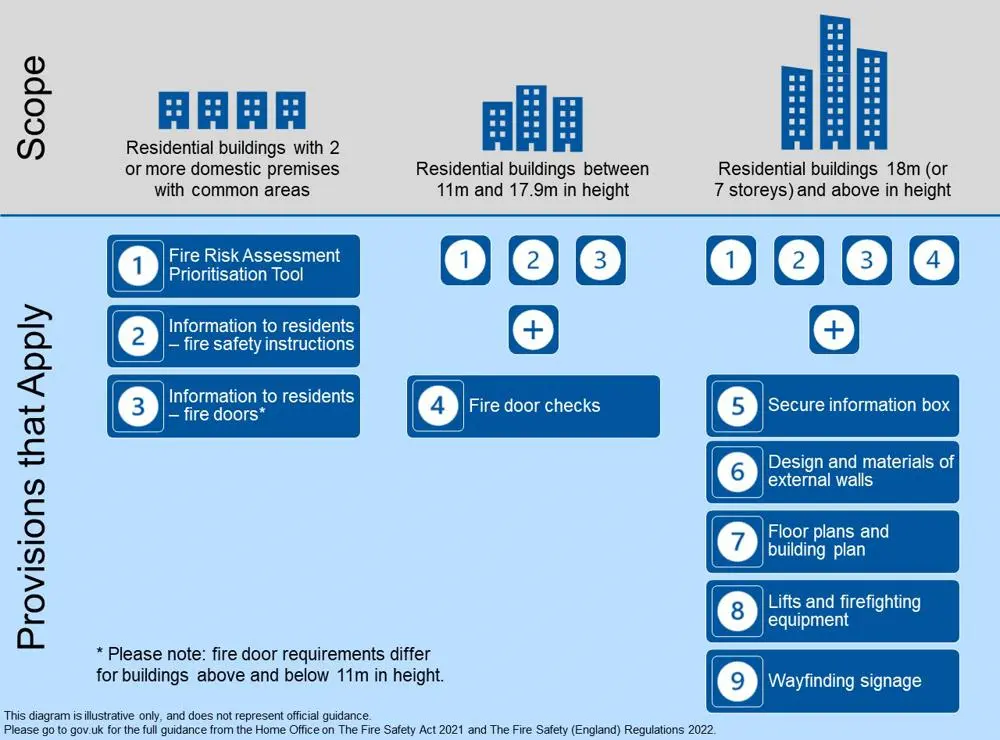Suffolk Fire And Rescue Service welcomes the commencement of the Fire Safety Act in England and Wales, and the Regulations in England, as important steps forward in strengthening the Fire Safety Order and improving fire safety. The Act clarifies that Responsible Persons (RPs) for multi-occupied residential buildings must manage and reduce the risk of fire for the structure and external walls of the building, including cladding, balconies and windows, and entrance doors to individual flats that open into common parts.
Fire Safety Act 2021
The Fire Safety Act 2021 (the Act) received Royal Assent on 29 April 2021 and commenced on 16 May 2022. The Act amends the Regulatory Reform (Fire Safety) Order 2005 (the Fire Safety Order).
What does the Fire Safety Act do?
The Act clarifies that where a building contains 2 or more sets of domestic premises, the Fire Safety Order applies to:
- the building’s structure and external walls (including windows, balconies, cladding, insulation and fixings) and any common parts
- all doors between domestic premises and common parts such as flat entrance doors (or any other relevant door).
Further information on the Fire Safety Act can be found at Fire Safety Act 2021 - GOV.UK (www.gov.uk)
Fire Safety (England) Regulations 2022
The Fire Safety (England) Regulations 2022 (the Regulations) have been introduced as an important step towards implementing the recommendations of the Grenfell Tower Inquiry Phase 1 report. The Regulations are being introduced under Article 24 of the Fire Safety Order and will come into force on 23 January 2023.
What do the Fire Safety (England) regulations require responsible persons to do?
Most of the requirements set out in the Regulations are imposed on the responsible person (RP), which RPs need to plan and prepare for ahead of the Regulations coming into force.
The regulations require RPs in multi-occupied residential buildings to take specific actions, depending on the height of the building:
- some provisions apply regardless of height
- more are needed once a building reaches 11 metres, and
- further requirements are introduced when a building reaches 18 metres (or 7 storeys) or more.
The Regulations apply to England only. The Regulations can be found at on the UK Government website.
You can find out more in the FAQs below and where to go for further information.
Fire Safety Act 2021 FAQs
Fire Safety (England) Regulations 2022 FAQs
Fire Risk Assessment Prioritisation Tool
The National Fire Chiefs Council NFCC has supported the Home Office Task and Finish Group in the production of a new Fire Risk Assessment Prioritisation Tool (FRAPT).
The FRAPT is an online tool designed to assist responsible persons to develop a strategy to prioritise their buildings to review their fire risk assessments, to ensure they take into account the clarifications outlined in the Act.
The Fire Risk assessment Tool can be accessed at Prioritise updating your fire risk assessments as a Responsible Person | Fire Risk Assessment Prioritisation Tool (bpt.homeoffice.gov.uk)
What do the Fire Safety (England) regulations require responsible persons to do?
Most of the requirements set out in the Regulations are imposed on the responsible person (RP), which RPs need to plan and prepare for ahead of the Regulations coming into force.
The regulations require RPs in multi-occupied residential buildings to take specific actions, depending on the height of the building:
- some provisions apply regardless of height
- more are needed once a building reaches 11 metres, and
- further requirements are introduced when a building reaches 18 metres (or 7 storeys) or more.

